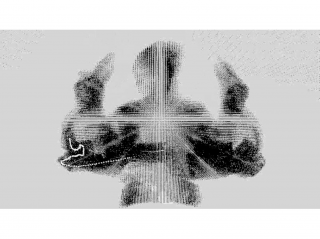Christine Doempke
Mercedes Blasco
Mimi Yin
Capturing Dance: Exploring Movement with Computer Vision
A series of studies for choreography using the Kinect to explore movement in three-dimensions, movement over time and movement through distortion, as well as new modes of interaction between dancers and musicians.
http://itp.nyu.edu/~mbe230/blogmer/capturing-dance

Classes
Computational Cameras,The Nature of Code
Computational Cameras,The Nature of Code
We've created a series of software "tools" for capturing and manipulating Kinect footage of a live dancer through sound and gesture cues.
With these tools, we've produced a set of pre-recorded videos that explore each of these tools in a short choreographic "study." Each study touches upon a different aspect of using visual imagery to underline and transform the live dance performance.
We've also begun to experiment with manipulating the abstracted, kinect imagery through sound as a way of visualizing the interaction between musician and dancer.
Background
Kinect
Sound libraries in Processing: Sonia, Minim
Audience
Kids and Adults.
User Scenario
We would like to show the videos alongside a live installation that allows viewers to interact with the tools we've created so they can experience some of the effects for themselves.
Viewers enter a controlled space where they see a video recording of our Kinect dance studies. As they watch, their image is also captured by the Kinect and they can experience many of the same effects they are seeing in the video.
Implementation
Kinect camera.
Laptop running Processing Sketch.
Microphone.
Screen.
2 Autopoles to support projectors and clamps
2 Projectors - 1 for the pre-recorded video. A second one for the live feed of viewers in the space.
Conclusion
15000 points is a lot of points to move with flocking algorithms, breaking code with ease.
Sound and frequency cues are inaccurate.
With these tools, we've produced a set of pre-recorded videos that explore each of these tools in a short choreographic "study." Each study touches upon a different aspect of using visual imagery to underline and transform the live dance performance.
We've also begun to experiment with manipulating the abstracted, kinect imagery through sound as a way of visualizing the interaction between musician and dancer.
Background
Kinect
Sound libraries in Processing: Sonia, Minim
Audience
Kids and Adults.
User Scenario
We would like to show the videos alongside a live installation that allows viewers to interact with the tools we've created so they can experience some of the effects for themselves.
Viewers enter a controlled space where they see a video recording of our Kinect dance studies. As they watch, their image is also captured by the Kinect and they can experience many of the same effects they are seeing in the video.
Implementation
Kinect camera.
Laptop running Processing Sketch.
Microphone.
Screen.
2 Autopoles to support projectors and clamps
2 Projectors - 1 for the pre-recorded video. A second one for the live feed of viewers in the space.
Conclusion
15000 points is a lot of points to move with flocking algorithms, breaking code with ease.
Sound and frequency cues are inaccurate.

